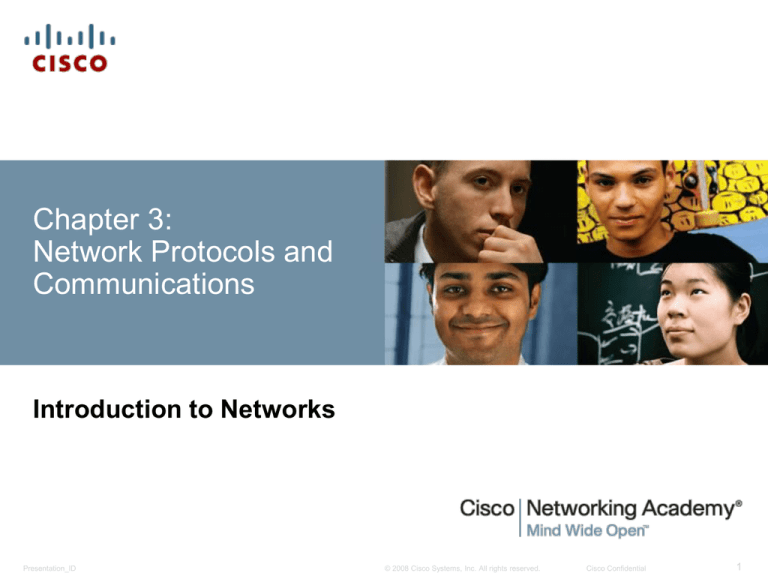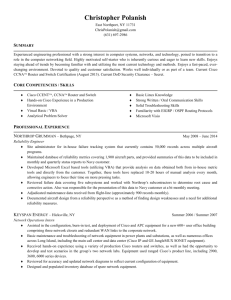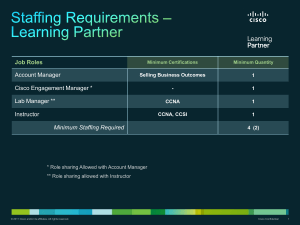
Chapter 3:
Network Protocols and
Communications
Introduction to Networks
Presentation_ID
© 2008 Cisco Systems, Inc. All rights reserved.
Cisco Confidential
1
Chapter 3
3.1 Rules of Communication
3.2 Network Protocols and Standards
3.3 Moving Data in the Network
3.4 Summary
Presentation_ID
© 2008 Cisco Systems, Inc. All rights reserved.
Cisco Confidential
2
The Rules
What is Communication?
Establishing the
Rules
An identified sender
and receiver
Agreed upon
method of
communicating
(face-to-face,
telephone, letter,
photograph)
Presentation_ID
Common language
and grammar
Speed and timing of
delivery
Confirmation or
acknowledgement
requirements
© 2008 Cisco Systems, Inc. All rights reserved.
Cisco Confidential
3
Protocol’s duty
Presentation_ID
© 2008 Cisco Systems, Inc. All rights reserved.
Cisco Confidential
4
The Rules
Message Encoding
Presentation_ID
© 2008 Cisco Systems, Inc. All rights reserved.
Cisco Confidential
5
The Rules
Message Formatting and Encapsulation
Presentation_ID
© 2008 Cisco Systems, Inc. All rights reserved.
Cisco Confidential
6
The Rules
Message Size
Segmenting
MSS – maximum segment size
Multiplexing
Presentation_ID
© 2008 Cisco Systems, Inc. All rights reserved.
Cisco Confidential
7
The Rules
Message Timing
Access Method
Full duplex
Half duplex
Flow Control
Response Timeout
Presentation_ID
© 2008 Cisco Systems, Inc. All rights reserved.
Cisco Confidential
8
The Rules
Message Delivery Options
Presentation_ID
© 2008 Cisco Systems, Inc. All rights reserved.
Cisco Confidential
9
Protocols
Rules that Govern Communications
Presentation_ID
© 2008 Cisco Systems, Inc. All rights reserved.
Cisco Confidential
10
Protocols
Network Protocols
How the message is formatted or structured
The process by which networking devices share information
about pathways with other networks
How and when error and system messages are passed
between devices
The setup and termination of data transfer sessions
Presentation_ID
© 2008 Cisco Systems, Inc. All rights reserved.
Cisco Confidential
11
Protocols
Interaction of Protocols
Presentation_ID
© 2008 Cisco Systems, Inc. All rights reserved.
Cisco Confidential
12
Protocol Suites
Protocol Suites and Industry Standards
Presentation_ID
© 2008 Cisco Systems, Inc. All rights reserved.
Cisco Confidential
13
Protocol Suites
Creation of Internet, Development of TCP/IP
http://cisco.edu.mn/CCNA_R&S_(Introduction_to_Networking
)/course/module3/index.html#3.2.2.2
Presentation_ID
© 2008 Cisco Systems, Inc. All rights reserved.
Cisco Confidential
14
Protocol Suites
TCP/IP Protocol Suite and Communication
http://cisco.edu.mn/CCNA_R&S_(Introduction_to_Network
ing)/course/module3/index.html#3.2.2.3
Presentation_ID
© 2008 Cisco Systems, Inc. All rights reserved.
Cisco Confidential
15
Exercise
http://cisco.edu.mn/CCNA_R&S_(Introduction_to_Networking
)/course/module3/index.html#3.2.2.4
Presentation_ID
© 2008 Cisco Systems, Inc. All rights reserved.
Cisco Confidential
16
Network Protocols and Standards
Standards Organizations
• The Internet Society (ISOC)
• The Internet Architecture
Board (IAB)
• The Internet Engineering
Task Force (IETF)
• Institute of Electrical and
Electronics Engineers
(IEEE)
• The International
Organization for Standards
(ISO)
Presentation_ID
© 2008 Cisco Systems, Inc. All rights reserved.
Cisco Confidential
17
Standards Organizations
ISOC, IAB, and IETF
Presentation_ID
© 2008 Cisco Systems, Inc. All rights reserved.
Cisco Confidential
18
Standards Organizations
IEEE
38 societies
130 journals
1,300 conferences each year
1,300 standards and projects
400,000 members
160 countries
Presentation_ID
© 2008 Cisco Systems, Inc. All rights reserved.
Cisco Confidential
19
Standards Organizations
ISO
Presentation_ID
© 2008 Cisco Systems, Inc. All rights reserved.
Cisco Confidential
20
Standards Organizations
Other Standards Organization
The Electronic Industries Alliance (EIA) – 19 inch racks
standarts
The Telecommunications Industry Association (TIA)- The
International Telecommunications Union – VoIP, satellite
Telecommunications Standardization Sector (ITU-T) - IPTV,
DSL
The Internet Corporation for Assigned Names and Numbers
(ICANN) The Internet Assigned Numbers Authority (IANA)
DNS
IP
AS number
Presentation_ID
© 2008 Cisco Systems, Inc. All rights reserved.
Cisco Confidential
21
Reference Models
The Benefits of Using a Layered Model
Presentation_ID
© 2008 Cisco Systems, Inc. All rights reserved.
Cisco Confidential
22
Reference Models
The OSI Reference Model
Presentation_ID
© 2008 Cisco Systems, Inc. All rights reserved.
Cisco Confidential
23
Reference Models
The TCP/IP Protocol Model
Presentation_ID
© 2008 Cisco Systems, Inc. All rights reserved.
Cisco Confidential
24
Reference Models
Comparing the OSI and TCP/IP Models
http://cisco.edu.mn/CCNA_R&S_(Introduction_to_Networking)/course/module3/inde
x.html#3.2.4.5
25
Presentation_ID
© 2008 Cisco Systems, Inc. All rights reserved.
Cisco Confidential
Data Encapsulation
Communicating the Messages
Segmenting message benefits
Different conversations can be interleaved
Increased reliability of network communications
Segmenting message disadvantage
Increased level of complexity
Presentation_ID
© 2008 Cisco Systems, Inc. All rights reserved.
Cisco Confidential
26
Data Encapsulation
Protocol Data Units (PDUs)
Data
Segment
Packet
Frame
Bits
Presentation_ID
© 2008 Cisco Systems, Inc. All rights reserved.
Cisco Confidential
27
Data Encapsulation
Encapsulation
Presentation_ID
© 2008 Cisco Systems, Inc. All rights reserved.
Cisco Confidential
28
Data Encapsulation
De-encapsulation
http://cisco.edu.mn/CCNA_R&S_(Introduction_to_Networking)/
course/module3/index.html#3.3.1.5
Presentation_ID
© 2008 Cisco Systems, Inc. All rights reserved.
Cisco Confidential
29
Moving Data in the Network
Accessing Local Resources
Presentation_ID
© 2008 Cisco Systems, Inc. All rights reserved.
Cisco Confidential
30
Accessing Local Resources
Communicating with Device / Same Network
Presentation_ID
© 2008 Cisco Systems, Inc. All rights reserved.
Cisco Confidential
31
Accessing Local Resources
MAC and IP Addresses
R1
192.168.1.1
11-11-11-11-11-11
ARP
Request
PC1
192.168.1.110
AA-AA-AA-AA-AA-AA
S1
R1
PC2
192.168.1.111
BB-BB-BB-BB-BB-BB
FTP Server
192.168.1.9
CC-CC-CC-CC-CC-CC
Presentation_ID
© 2008 Cisco Systems, Inc. All rights reserved.
Cisco Confidential
32
Accessing Remote Resources
Default Gateway
PC 1
192.168.1.110
AA-AA-AA-AA-AA-AA
R2
172.16.1.99
22-22-22-22-22-22
R1
192.168.1.1
11-11-11-11-11-11
Web Server
172.16.1.99
AB-CD-EF-12-34-56
PC 2
192.168.1.111
BB-BB-BB-BB-BB-BB
Presentation_ID
FTP Server
192.168.1.9
CC-CC-CC-CC-CC-CC
© 2008 Cisco Systems, Inc. All rights reserved.
Cisco Confidential
33
Accessing Remote Resources
Communicating Device / Remote Network
Presentation_ID
© 2008 Cisco Systems, Inc. All rights reserved.
Cisco Confidential
34
Accessing Remote Resources
Using Wireshark to View Network Traffic
http://cisco.edu.mn/CCNA_R&S_(Introduction_to_Networking)/course/files/3.3.3.4%20L
ab%20-%20Using%20Wireshark%20to%20View%20Network%20Traffic.pdf 35
Presentation_ID
© 2008 Cisco Systems, Inc. All rights reserved.
Cisco Confidential
Password phrase
“My favorite spy is James Bond 007.” = MfsiJB007.
“It was the best of times, it was the worst of times.” = Iwtbotiwtwot.
“Fly me to the moon. And let me play among the stars.” = FmttmAlmpats
To increase the security of passwords, the following Cisco
IOS commands should be utilized:
Enforce minimum password length: security passwords minlength.
Disable unattended connections: exec-timeout.
Encrypt config file passwords: service password-encryption.
Presentation_ID
© 2008 Cisco Systems, Inc. All rights reserved.
Cisco Confidential
36
Enforce Minimum Password Lengths
Make passwords lengthy.
IOS 12.3 and later passwords can be 0 to 16 characters in length.
The best practice is to have a minimum of 10 characters.
To enforce the minimum length use the global command:
security passwords min-length length
The command affects all “new” router passwords.
Existing router passwords are unaffected.
Any attempt to create a new password that is less than the
specified length fails and results in an “Password too short”
error message.
Presentation_ID
© 2008 Cisco Systems, Inc. All rights reserved.
Cisco Confidential
37
Disable Unattended Connections
By default, an administrative interface stays active and logged in
for 10 minutes after the last session activity.
After that, the interface times out and logs out of the session.
The timer can be adjusted using the exec-timeout command
in line configuration mode for each of the line types that are used.
exec-timeout minutes seconds
Note:
exec-timeout 0 0 means that there will be no timeout and the
session will stay active for an unlimited time.
Great for Labs …
Bad in production networks!
Never set the value to 0!
Presentation_ID
© 2008 Cisco Systems, Inc. All rights reserved.
Cisco Confidential
38
Disable Unattended Connections
Default time is 10 minutes.
Terminates an unattended connection (console or vty).
Provides additional level of security if an administrator walks away
from an active console session.
Router(config-line)#
exec-timeout minutes [seconds]
To terminate an unattended console connection after 3 minutes and 30
seconds:
Sudbury(config)# line console 0
Sudbury(config-line)# exec-timeout 3 30
To disable the exec process on the line:
Sudbury(config)# line aux 0
Sudbury(config-line)# no exec-timeout
Presentation_ID
© 2008 Cisco Systems, Inc. All rights reserved.
Cisco Confidential
39
Encrypt All Passwords
• Encrypt all passwords in the router configuration file.
Router(config)#
service password-encryption
R1(config)# service password-encryption
R1(config)# exit
R1# show running-config
enable password 7 06020026144A061E
!
line con 0
password 7 094F471A1A0A
login
!
line aux 0
password 7 01100F175804575D72
login
line vty 0 4
password 7 03095A0F034F38435B49150A1819
login
Presentation_ID
© 2008 Cisco Systems, Inc. All rights reserved.
Cisco Confidential
40
Securing Local Database Passwords
Secure the local database passwords.
Traditional user configuration with plaintext password.
username name password {[0] password | 7 hidden-password}
Use MD5 hashing for strong password protection.
More secure than the type 7 encryption.
username name secret {[0] password | encrypted-secret}
Presentation_ID
© 2008 Cisco Systems, Inc. All rights reserved.
Cisco Confidential
41
Network Protocols and Communications
Summary
In this chapter, you learned:
Data networks are systems of end devices, intermediary
devices, and the media connecting the devices. For
communication to occur, these devices must know how to
communicate.
These devices must comply with communication rules and
protocols. TCP/IP is an example of a protocol suite.
Most protocols are created by a standards organization such
as the IETF or IEEE.
The most widely-used networking models are the OSI and
TCP/IP models.
Presentation_ID
© 2008 Cisco Systems, Inc. All rights reserved.
Cisco Confidential
42
Network Protocols and Communications
Summary
In this chapter, you learned:
Data that passes down the stack of the OSI model is
segmented into pieces and encapsulated with addresses and
other labels. The process is reversed as the pieces are deencapsulated and passed up the destination protocol stack.
The OSI model describes the processes of encoding,
formatting, segmenting, and encapsulating data for
transmission over the network.
The TCP/IP protocol suite is an open standard protocol that
has been endorsed by the networking industry and ratified, or
approved, by a standards organization.
Presentation_ID
© 2008 Cisco Systems, Inc. All rights reserved.
Cisco Confidential
43
Network Protocols and Communications
Summary
In this chapter, you learned:
The Internet Protocol Suite is a suite of protocols required for
transmitting and receiving information using the Internet.
Protocol Data Units (PDUs) are named according to the
protocols of the TCP/IP suite: data, segment, packet, frame,
and bits.
Applying models allows individuals, companies, and trade
associations to analyze current networks and plan the
networks of the future.
Presentation_ID
© 2008 Cisco Systems, Inc. All rights reserved.
Cisco Confidential
44
Presentation_ID
© 2008 Cisco Systems, Inc. All rights reserved.
Cisco Confidential
45




